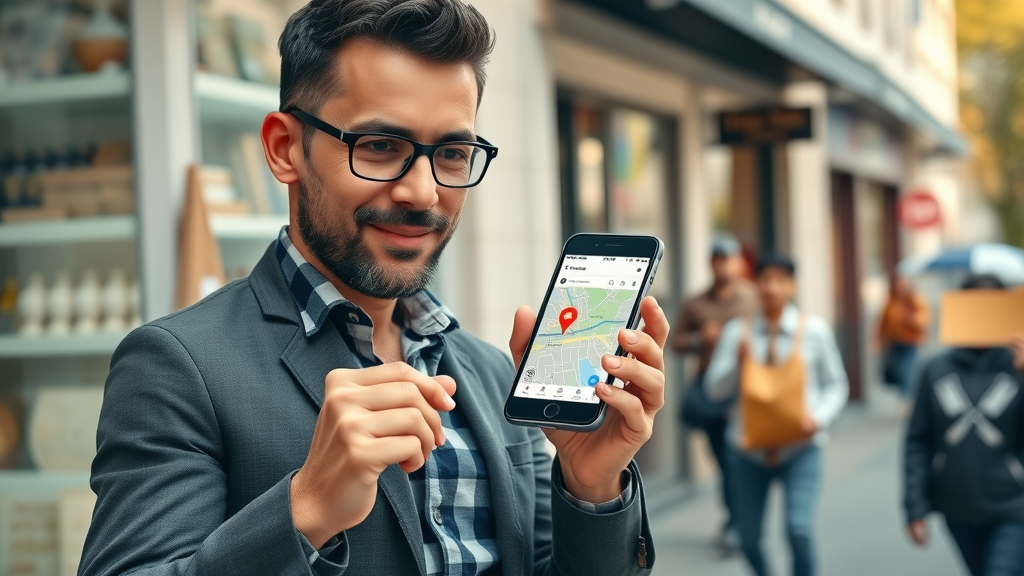In 2024, over 78% of mobile local searches result in an offline purchase—yet less than half of small businesses use a dedicated local SEO strategy? This means your business could be missing out on a wave of walk-in customers ready to buy. If you want your local business to thrive against nearby competitors, mastering local SEO techniques is not just an option—it’s critical for sustaining and boosting your real-world sales. If you’re ready to unlock growth, keep reading to see the strategies proven to deliver rapid, measurable results for small businesses in your community.
Unlocking Small Business Success with Local SEO Techniques: Surprising Stats & Current Trends
In 2024, over 78% of mobile local searches result in an offline purchase, yet less than half of small businesses have a dedicated local SEO strategy. Discover why leveraging advanced local SEO techniques is no longer optional for thriving in today’s search-driven marketplace.

The numbers don’t lie: businesses that invest in local SEO techniques consistently attract more local traffic, achieve higher rankings in local search results , and convert online visitors to in-store customers. While national brands compete on broad visibility, small businesses that focus on Google Business Profile optimization , up-to-date business information , and targeted local keyword research are setting themselves up for big wins. Ignoring these strategies can leave you invisible to potential customers actively seeking your services, especially as mobile searches become the norm. We’ll break down not only what you need to implement, but why your business can’t afford to wait.
Essential Local SEO Techniques for Dominating Local Search
Understanding Local SEO: Definition, Benefits, and Core Ranking Factors
Breakdown of local SEO, how it differs from general SEO, and why it’s vital for small businesses.
Introduction to core ranking factors for local search in 2024, including business profile consistency, Google business optimization, and on-page SEO alignment.

Local SEO is the art and science of optimizing your online presence so your business surfaces in search engine results when local customers are actively searching for your products or services. Unlike broad SEO—which targets national or global keywords— local SEO techniques prioritize location-based queries, such as "find local coffee shop near me." This distinction is crucial because potential customers are more likely to visit or call a business that appears at the top of their local search results.
The key to dominating local search lies in three main ranking factors : consistency (ensuring your business name, address, and phone number—NAP—are uniform across platforms), robust Google Business Profile optimization, and tight alignment between your site content and your local business area. In 2024, search engines weigh these factors heavily, rewarding businesses that provide detailed, accurate, and up-to-date business information . Ignoring these ranking factors often leads to missed opportunities and diminished visibility in competitive markets.
Creating an Effective Local SEO Strategy for Local Business Growth
Steps to develop a robust local SEO strategy tailored for small businesses and local businesses.
Overview of integrating local keyword research, Google business profile setup, and targeted content for higher search engine visibility.
“Local SEO is the bridge between online searches and real-world sales—mastering it is non-negotiable for small business success.” – Industry Expert
Crafting a successful local SEO strategy begins with identifying your target audience and understanding the specific needs of local customers . Start by conducting comprehensive keyword research focused on phrases that combine your service type with your location (e.g., "Long Island bakery open late"). Next, claim and optimize your Google Business Profile , ensuring every field is complete, accurate, and up-to-date. Enhance your approach with on-page SEO techniques, such as structuring your site for easy navigation, using local business schema markup, and including local citations.
Don’t overlook the importance of generating location-rich content and securing backlinks from reputable community organizations or news outlets. Each action—aligned to core ranking factors —bolsters your visibility in local search results and strengthens the connection between your online presence and offline success.
Optimizing Your Google Business Profile with Proven Local SEO Techniques
Setting Up and Enhancing Your Google Business Profile
Step-by-step tutorial for creating a Google business profile and optimizing it for maximum local search reach.
Tips for perfecting Business Profile categories, descriptions, and utilizing images.

To claim your space in local search results, begin by creating or claiming your Google Business Profile . Visit the Google Business platform, input your accurate business information (including hours and address), and verify your listing. After verification, optimize your business profile by selecting the most relevant categories, adding a compelling business description fortified with local keywords, and uploading high-quality images of your storefront, services, and team. Remember, profiles with complete information and vivid imagery attract more potential customers searching on both Google Search and Google Maps .
Regularly update your profile with seasonal offers, events, and new photos to keep your listing fresh. Don’t underestimate the value of answering questions and posting updates—these small actions can elevate your ranking factor and entice more customers to choose your business over competitors.
Managing Reviews and User Engagement on Google Maps
Best practices for gathering, responding to, and leveraging customer reviews as a ranking factor.
Gathering reviews is critical to your local SEO success. Encourage satisfied customers to leave positive feedback by sending follow-up requests via email or SMS. Responding promptly to reviews—both positive and negative reviews—signals to search engines and users that your business is engaged, reliable, and trustworthy. Never ignore a negative review; always address concerns professionally to demonstrate your commitment to customer satisfaction. High-quality, consistent reviews boost your Google Maps ranking and enhance your business’ prominence in local search.
Leverage user-generated content as part of your SEO strategy by highlighting testimonials, sharing customer photos, and engaging with users who ask questions through your Google Business Profile . The more active your profile, the more visible and appealing it becomes to both search engines and potential customers.
Comparison of Google Business Profile Features That Impact Local SEO |
||
Profile Field |
Impact on Local SEO |
Best Practice |
|---|---|---|
Categories |
Defines your appearance in local search for relevant services. |
Select the most specific, accurate primary and secondary categories. |
Business Description |
Informs users and search engines about your services and strengths. |
Use local keywords and unique selling points. |
Images |
Increases profile engagement and conversion rates. |
Upload fresh, high-quality photos regularly. |
Reviews |
Boosts trust and signals prominence to search engines. |
Encourage and respond to every review. |
Posts & Updates |
Encourages user actions and keeps your profile dynamic. |
Post about events, promotions, and new products often. |
Mastering Local Keyword Research and On-Page Optimization for Small Businesses
Conducting Local Keyword Research for Maximum Discoverability
How to find local keywords relevant to your local business and implement them in your content strategy.

Successful local SEO starts with intensive local keyword research . Apply keyword tools—like Google Keyword Planner, Ahrefs, or Moz—to discover phrases potential customers use when searching for businesses like yours in your region. Key modifiers include your city, neighborhood, ZIP code, and service (e.g., "emergency plumber in Brentwood NY"). Investigate competitors’ site copy and Google Business Profile descriptions for inspiration, but avoid direct copying.
Once you’ve collected a list of high-potential local keyword phrases, integrate them naturally throughout your website’s key meta elements (title tags, meta descriptions, headings), page copy, and even image filenames and alt text. Strive for relevance and authenticity: content should provide real value rather than simply stuffing keywords.
On-Page SEO Techniques for Boosting Local Business Profile Rankings
Optimizing website and landing pages for local search using structured data, local business schema, and accurate NAP consistency.
Including city, region, and service-based modifiers as part of an advanced local SEO strategy.
Checklist of local SEO on-page elements (title tags, meta descriptions, headers, internal linking) for local businesses.

Ensure your business info —including NAP—is consistent across your site. Implement structured data and utilize a Local Business Schema to give search engines additional context about your location, hours, and services. Every landing page should mention your city, neighborhood, and service area naturally within headers and body copy. Link to location-specific content and use internal links to guide users (and bots) to your contact page, about section, and location listings.
Here’s a quick on-page local SEO checklist for small businesses :
Title Tags: Include your main service and city (e.g., "Best Italian Restaurant in Huntington, NY")
Meta Descriptions: Summarize your offering and location in 160 characters
Headers: Use H2s and H3s with regional modifiers
Internal Linking: Link to key service pages and contact details
Schema Markup: Add local business schema JSON-LD on every page
Consistent NAP: Same exact spellings sitewide and across directories
Leveraging Citations, Directories, and Backlinks for Enhanced Local Search Authority
Submitting Your Business to Key Local Directories
Step-by-step guide to submitting and maintaining consistent business information across directories.
How directory citations influence local SEO and ranking factor insights for local businesses.

Submitting your business to trusted local directories remains one of the most reliable local SEO techniques . Start with the major players: Google Business , Bing Places, Yelp, Facebook Business, Yellow Pages, and your local chamber of commerce listing. Ensure your business information (name, address, phone) matches your website and other platforms exactly. This uniformity not only avoids confusion for potential customers , but also boosts trust in the eyes of search engines .
Regularly audit your citations using tools like Moz Local or BrightLocal to correct any outdated or inconsistent listings. The more consistent and widespread your citations, the stronger your authority and the higher your local rankings .
Building Local Backlinks That Drive Credibility and Traffic
Strategies for earning location-based backlinks from newspapers, community blogs, chambers of commerce, and business associations.
The impact of high-authority local backlinks on your search engine ranking factors.
Top Platforms for Local SEO Citations and Backlinks: Google Business, Bing Places, Yelp, Facebook Business, Yellow Pages, Chamber of Commerce, Hyperlocal sites
“Consistency and relevancy with local citations can significantly boost your rankings and bring more customers to your door.”
Develop relationships with fellow local businesses , community organizations, and the local media. Offer to guest post, share community event updates, or sponsor events to earn backlinks from their websites. These links count as strong authority signals to search engines , showing that your business is a respected part of the local ecosystem.
Local backlinks are more than just traffic drivers—they reinforce your location to search engines and can tip ranking factors in your favor. Incorporate backlink building into your ongoing SEO strategy for long-term improvements in both traffic and trust.
Utilizing Google Maps and Mobile Optimization in Your Local SEO Techniques
How Google Maps Integration Boosts Local Business Visibility
Integrating Google Maps on your website and within your business profile improves local rankings and user trust.

Embedding Google Maps on your website with your pin highlighted makes it easy for potential customers to locate you and increases time spent on site—both positive ranking factors for local search . Adding a map to your contact page also signals to Google Search that your business is legitimate and should be prioritized for local queries.
Additionally, optimizing your Google Business Profile for map listings, such as by confirming your location and updating hours, helps you rank higher in Google Maps search results. Trust is boosted when customers see an accurate map and can seamlessly get directions to your door right from their smartphone.
Mobile Optimization: A Core Ranking Factor in Local SEO Techniques
Why mobile-first design and fast load speeds are mission-critical for local business and search engine rankings.
Mobile vs. Desktop Performance Metrics for Local SEO |
||||
Device |
Click-Through Rate (CTR) |
Bounce Rate |
Conversion Rate |
Time on Page |
|---|---|---|---|---|
Mobile |
6.4% |
47% |
5.8% |
1:33 min |
Desktop |
5.1% |
29% |
4.7% |
2:18 min |
With more than half of all local searches happening on mobile, a mobile-first website design is non-negotiable. A responsive, fast-loading site enhances the user experience and signals to search engines that your site deserves to rank for local search queries. Compress images, streamline your pages, and eliminate unnecessary scripts or plugins that could slow load time.
By prioritizing mobile performance, you’ll reduce bounce rates and increase conversions—making your site more attractive to both search engines and local customers scanning for nearby solutions on their phones.
Developing Local Content and Community Engagement Strategies
Creating Hyperlocal Content That Resonates with Your Audience
Local content ideas: event roundups, case studies, customer stories, and local business news.
How local blog content supported by targeted local keywords can catalyze audience growth.

Hyperlocal content connects you deeply with your target audience and helps differentiate your business from faceless corporate competitors. Cover topics relevant to your city or neighborhood: post event calendars, write business case studies, and share customer success stories. Consistently publishing blogs or video recaps of local happenings helps you build topical authority and attract backlinks from community partners.
Use strategically placed local keywords in your content—without overdoing it—to signal to search engines that your business is a hub of local expertise. The result? You’ll draw more site traffic from those who are most likely to become loyal customers.
Harnessing Social Proof and Local Influencer Partnerships
Steps for small business owners to partner with local influencers and amplify Google business profiles.
Tips for using reviews, testimonials, and case studies as ranking factors in your local SEO strategy.

Ideas for community engagement: sponsoring local events, hosting workshops, running promotions with other local businesses.
“Your local presence is amplified when you actively collaborate and engage within your community online and offline.”
Forge partnerships with local influencers or micro-influencers who already have the trust of your target audience. Invite them to experience your services and share reviews or testimonials on their platforms as well as on your Google Business Profile . Genuine endorsements greatly boost visibility and provide trustworthy social proof that can sway undecided potential customers .
Feature customer testimonials, user-generated content, and real-life case studies prominently on your site and across social media. These are not only powerful ranking factors for local SEO , but also foster deeper community bonds. By engaging with other businesses—perhaps co-sponsoring events or sharing campaigns—you broaden your reach and reinforce your position as a community leader.
Measuring and Refining Your Local SEO Strategy: Key Metrics and Tools
Monitoring Local Keywords, Rankings, and Business Profile Insights
Overview of top tools for tracking local search rankings, business profile performance, and Google business analytics.
Identifying actionable insights using tools like Google Search Console, Moz Local, BrightLocal, and SEMrush.

To maximize your return on investment, regularly track how your local keywords and business listings are performing. Essential tools include Google Search Console (for rankings and click-through rates), Moz Local and BrightLocal (for citation and listing audits), and your Google Business Profile dashboard (for tracking views, calls, and direction requests).
Review trends in customer engagement, search visibility, and listing interaction frequency. With these analytics, you can spot what’s working and identify gaps in your local SEO coverage. For instance, if certain keywords drive most leads, invest more content and link-building efforts around them.
Adjusting Local SEO Techniques Based on Data-Driven Insights
How to interpret analytics reports to improve your local SEO strategy continuously.
Testing and tweaking Google business profile elements, local keywords, and on-page SEO for better local search results.
List of Must-Track Local SEO Metrics |
|
Metric |
Description |
|---|---|
GMB Insights |
Tracks profile views, searches, and actions taken by users |
Calls |
Monitors customer inquiries via phone from your profile |
Direction Requests |
Shows how many users sought directions to your business |
Reviews |
Quality, quantity, and frequency of reviews |
Organic Rankings |
Performance of your target local keywords in search engines |
Citations Score |
Overall citation consistency and accuracy across directories |
Use these insights to fine-tune your strategy each month. Test updating business hours, adjusting keyword focus, or improving on-page elements to see what influences your local search performance. The most successful small businesses are those that adapt quickly based on real data rather than guesswork.
Regularly re-evaluate Google Business Profile categories, landing page relevance, and backlink opportunities. Experiment and measure—then double down on what’s driving real results!
Best Practices and Advanced Local SEO Techniques for Small Businesses
Advanced local SEO tips: Geo-tagging images, local landing pages for each location, utilizing FAQ schemas, voice search optimization, leveraging Google Posts on your business profile.
Mistakes to avoid: NAP inconsistencies, ignoring mobile optimization, neglecting reviews, and failing to update citations.
Future trends: Integrating AI, video content, and social listening into local SEO strategies for greater local business visibility.

“Small businesses that adapt local SEO techniques quickly are best positioned to capture new markets and beat the competition.”
Advanced local SEO techniques can make your small business impossible to ignore. Geo-tag photos before uploading them, create a dedicated landing page for each of your locations, and add FAQ schema to your site to answer common questions directly in search results . Stay ahead by optimizing for voice search queries, as more customers use smartphones and smart speakers for recommendations. Leverage Google Posts to announce promotions, events, or service updates right on your Google Business Profile .
Steer clear of common mistakes like inconsistent NAP data, failing to respond to reviews, or letting business listings go stale. As digital behavior evolves, keep an eye on trends like AI-driven analytics, interactive video content, and social listening tools to anticipate new local search opportunities before your competitors do.
Common Questions about Local SEO Techniques for Small Businesses
What is the best strategy for local SEO?
Focusing on Google business profile optimization, targeted local keyword research, citation building, and consistent content creation yields the best results for local SEO.
The optimal local SEO strategy blends comprehensive Google Business Profile optimization, precise local keyword targeting, citation building across trusted directories, and regular publication of unique, location-specific content. Regularly update your business information and encourage customer reviews to maintain authority and visibility.
How do I do local SEO?
Claim your Google business profile, optimize all listings, conduct local keyword research, build citations, and create unique local content to effectively execute local SEO techniques.
Start by claiming and verifying your Google Business Profile . Optimize all digital listings for accuracy and consistency, conduct deep keyword research for local search terms, submit your info to key directories, and consistently generate fresh content that reflects local events, news, or promotions. Track performance and make adjustments for ongoing improvement.
What are the different types of local SEO?
Types of local SEO include citation building, on-page optimization, reputation management, geo-targeted content, and local link building strategies.
The main local SEO techniques fall into five categories: citation building to establish authority, on-page optimization for targeting local keywords and NAP consistency, managing your online reputation through reviews, creating geo-targeted content, and building backlinks from relevant community sources.
What are the three pillars of local SEO?
The three foundational pillars are relevance (content and keywords), proximity (distance to searcher), and prominence (reviews and authority signals).
Relevance ensures your website content matches what users are searching for, proximity refers to how close your business is to the searcher’s location, and prominence covers your business’ reputation, including reviews, citations, and backlinks—together these pillars determine your local search visibility.
Key Takeaways: Why Small Businesses Should Prioritize Local SEO Techniques
Summary of the most effective local SEO techniques tailored for small business growth and the importance of continuous adaptation.
Encouragement for small business owners to integrate the outlined steps using local SEO as a competitive advantage.
Implementing these local SEO techniques is essential for small businesses seeking immediate growth. Adapt, optimize, and engage consistently to outpace your competition and turn searchers into loyal customers.
Ready to Accelerate Your Local SEO Success on Long Island?
Ready to make waves on Long Island? Let’s chart your course today! Call 631 629 5553
Ready to make waves on Long Island? Let’s chart your course today! Call 631 629 5553
To further enhance your understanding of local SEO techniques, consider exploring the following resources:
“14 Local SEO Strategies & Tips” ( seo.co )
This article provides a comprehensive guide on various local SEO strategies, including the importance of setting up social profiles, using local keywords, ensuring website responsiveness, and optimizing title tags and meta descriptions.
“What Is Local SEO and How to Improve Your Local Ranking” ( sproutsocial.com )
This resource delves into the fundamentals of local SEO, offering insights on claiming and optimizing your Google My Business listing, the significance of mobile optimization, and the role of customer reviews in enhancing local search rankings.
By delving into these resources, you’ll gain a deeper understanding of effective local SEO techniques and how to implement them to boost your business’s visibility in local search results.
 Add Row
Add Row  Add
Add 




Write A Comment